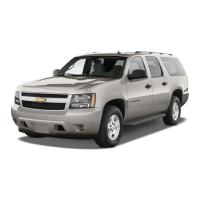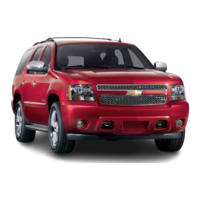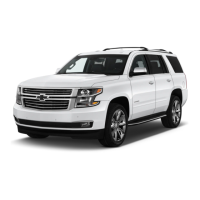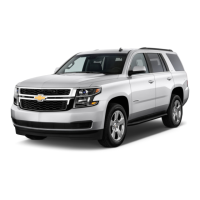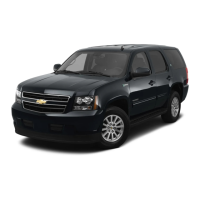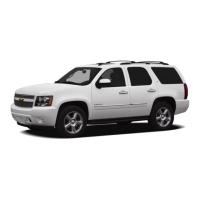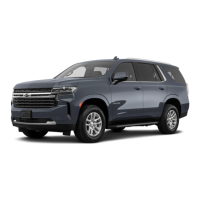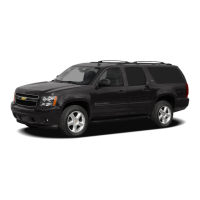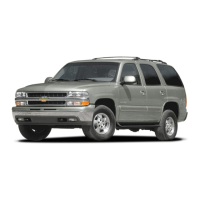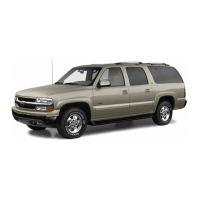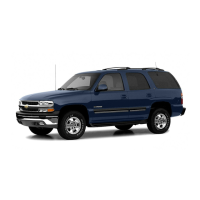Do you have a question about the Chevrolet Tahoe 2015 and is the answer not in the manual?
Information on risks of fatal injury, accidents, injury, or vehicle damage. Includes symbols and their meanings.
Explanation of symbols used for components, controls, messages, gauges, or indicators.
Provides additional symbols found on the vehicle and their meanings.
Overview of the instrument panel, including locations of various controls and indicators.
Brief overview of important vehicle features for initial driving.
Details on using the RKE transmitter for remote locking/unlocking doors and liftgate.
Information on starting the vehicle's engine remotely using the RKE transmitter.
Procedures for locking and unlocking doors from inside and outside the vehicle.
Information on power windows, including express-down and express-up features.
Instructions for adjusting manual and power seats, including lumbar support.
Details on saving and recalling memory settings for seats, mirrors, and steering column.
Information on folding third row seatbacks for cargo space and head restraint adjustment.
Guidelines on proper use of safety belts and their importance for occupant protection.
Explanation of how the passenger sensing system affects airbag deployment based on occupant presence.
Instructions for adjusting exterior and interior mirrors, including power and auto-dimming features.
Procedures for adjusting the steering wheel for tilt and telescope positions.
How to adjust the position of the throttle and brake pedals, if equipped.
Controls for dome lamps and reading lamps, including settings for door activation.
Controls for exterior lamps, including automatic headlamps and fog lamps.
Operation of windshield wipers and washers, including Rainsense™ feature.
Operation of the heating, cooling, and ventilation system.
Information on automatic transmission operation and range selection mode.
Explanation of four-wheel drive modes and transfer case operation.
Overview of various vehicle features and systems.
Details on the infotainment system, including radio, audio players, and phone functions.
Information on SiriusXM satellite radio service and reception.
Operation and features of the cruise control system.
System designed to help avoid or reduce harm from front-end crashes.
System to help avoid unintentional lane departures using a camera sensor.
Lane-changing aid assisting drivers with avoiding lane change crashes.
Displays a view of the area behind the vehicle when shifted into Reverse.
Uses sensors to assist with parking and avoiding objects while in Reverse.
Information on accessory power outlets for plugging in electrical equipment.
Operation of the sunroof, including opening, closing, and venting.
System operation for limiting wheel spin and assisting directional control.
System that monitors tire pressure levels and warns of underinflation.
Calculates engine oil life and indicates when oil change is necessary.
Details on vehicle keys, lock systems, and remote keyless entry functions.
Information on the keyless access system and programming keys.
Operation of the RKE transmitter for locking, unlocking, and remote start.
Customizing vehicle features such as lighting, locks, and mirrors.
Information on the theft-deterrent features and alarm system operation.
Procedures for opening and closing the liftgate and liftglass.
Operation of power assist steps, including deployment and retraction.
Overview of the vehicle's theft-deterrent features and alarm system.
Details on adjusting and operating exterior mirrors, including power, folding, and heated features.
Instructions for adjusting power mirrors, including folding and resetting functions.
How to manually fold mirrors for car washes or to prevent damage.
Operation of heated mirrors for clearing fog or frost.
Information on the convex mirror designed to show objects in the vehicle's blind zone.
Exterior mirrors that tilt automatically when the vehicle is shifted into Reverse.
Adjusting the interior rearview mirror and features like auto-dimming.
Information on power windows, including express features and lockout.
Instructions for operating power windows, express features, and reprogramming.
How to use sun visors to block glare and pivot them.
Operation of the sunroof, including opening, closing, venting, and sunshade.
Information on adjustable head restraints for front seats and proper installation.
Details on seat adjustment, including manual, power, and lumbar adjustments.
Information on second row seats, including reclining and folding features.
Instructions for folding and tumbling third row seats.
Operation of heated and cooled front seats.
Guidelines on proper use of safety belts and their importance.
Instructions for adult-sized occupants on proper safety belt usage.
Proper use of lap-shoulder belts, including adjustments and warnings.
Overview of the vehicle's airbag system, including types and warnings.
Locations of the various airbags within the vehicle.
Explanation of factors determining airbag deployment thresholds.
System that detects occupant presence to control front passenger airbag deployment.
Guidelines for selecting and using child restraints for older children and infants.
Proper use of safety belts by older children who have outgrown booster seats.
Importance of child restraints and safety precautions for infants and young children.
Instructions for properly securing child restraints using vehicle safety belts or LATCH.
Overview of child restraint systems, including rear-facing infant seats.
Ensuring the child is properly secured in the child restraint.
Recommendations for the safest seating positions for child restraints.
Information on using LATCH attachments and top tether anchors for child restraints.
Location and use of top tether anchors for securing child restraints.
Location of top tether anchors for bucket-style second row seats.
Procedure for returning folded or tumbled seats to their upright position.
Overview of various storage compartments within the vehicle.
Details on storage behind the radio, including USB port.
Instructions for opening the glove box.
Location and operation of sunglasses storage on the overhead console.
Features and contents of the center console storage area.
Additional storage options and features available in the vehicle.
Instructions for using and removing the cargo cover.
Information on the roof rack system for carrying items and related warnings.
Overview of various vehicle controls and their functions.
Procedures for adjusting the steering wheel for tilt and telescope.
Controls on the steering wheel for audio, phone, and voice recognition.
Operation of the heated steering wheel feature.
Operation of windshield wipers and washers, including Rainsense™.
Operation of the heating, cooling, and ventilation system.
Information on automatic transmission operation.
Explanation of four-wheel drive modes and transfer case operation.
Explanation of various warning lights, gauges, and indicators on the instrument cluster.
Overview of the base and uplevel instrument clusters.
Details on the Driver Information Center (DIC) displays and menu items.
Explanation of messages displayed on the DIC indicating vehicle status or actions.
How to control heating, cooling, and ventilation, including automatic operation.
Information on adjustable air vents and operation tips.
Procedures for replacing the passenger compartment air filter.
Guidelines for servicing the air conditioning system and refrigerant.
Guidance on safe driving practices, including distracted and drunk driving.
Tips to avoid distraction while driving.
Factors influencing vehicle control, including braking and steering.
Explanation of braking action, reaction time, and helpful braking tips.
Information on electric power steering and steering in emergencies.
Tips for recovering a vehicle from off-road situations.
Understanding and responding to skidding situations.
Techniques for driving in various traction-reducing conditions.
Safe driving practices for steep and rolling terrain.
Warnings and precautions for driving through water.
Tips for driving safely on wet roads and handling hydroplaning.
Procedures for freeing a vehicle stuck in snow, mud, or sand.
Importance of knowing vehicle weight capacity and how to calculate load limits.
Guidelines for new vehicle break-in and operating procedures.
How to adjust the position of the throttle and brake pedals.
Explanation of the ignition switch positions for key access vehicles.
Operation of the electronic keyless ignition with pushbutton start.
Procedure for stopping the engine and locking the vehicle.
Steps for starting the engine using key access or keyless ignition.
Explanation of torque lock and how to prevent it.
Procedure for shifting the transmission out of Park.
How the system operates the engine on different cylinder modes.
Overview of the automatic transmission and shift lever positions.
Using Range Selection Mode to control transmission and vehicle speed.
Assists vehicle acceleration in slippery conditions.
Adjusts transmission shift pattern for heavy loads or towing.
Operation and settings for the four-wheel drive system.
Information on the vehicle's brake system, including ABS and parking brake.
Explanation of the ABS system and its function.
Procedure for setting and releasing the parking brake.
Feature designed to assist driver in stopping or decreasing vehicle speed.
Feature to prevent vehicle rolling when stopped on a grade.
Overview of traction control and electronic stability control systems.
System operation, limitations, and how to turn systems off and on.
System for maintaining vehicle speed when driving downhill.
Semi-active damping system for improved ride and handling.
Feature for increased traction on snow, mud, ice, sand, or gravel.
System that provides a better leveled riding position and handling.
Operation and safety warnings for cruise control.
System allowing driver to select speed and following gap.
Features that help avoid crashes or reduce damage.
Rear Vision Camera, Parking Assist, Front Parking Assist, and RCTA.
System to help avoid or reduce harm from front-end crashes.
Feature to help reduce crash damage by applying vehicle brakes.
Lane-changing aid to avoid crashes with vehicles in blind zones.
Lane-changing aid to avoid crashes with vehicles rapidly approaching from behind.
System to help avoid crashes due to unintentional lane departures.
Information on recommended fuel types and usage.
Fuels that should not be used in the vehicle.
Vehicle requirements for California Emissions Standards.
Procedure for safely filling the fuel tank.
Safety precautions for filling portable fuel containers.
General information and tips for towing a trailer.
Guidance on handling and braking when towing a trailer.
Determining safe trailer weight and tongue load.
Information on hitches, safety chains, and trailer brakes.
Details on the seven-pin trailer connector and its circuits.
Feature to assist with heavy loads or towing.
System for use with electric trailer brakes.
Importance of routine maintenance and dealer services for vehicle care.
Guidance on performing basic vehicle checks and service work.
Procedure for opening and closing the vehicle hood.
Diagram and identification of components in the engine compartment.
Ensuring proper engine performance by maintaining engine oil.
How to check the engine oil level and interpret the dipstick readings.
System that indicates when to change engine oil and filter.
Procedures for checking and changing automatic transmission fluid.
Inspection and replacement of the engine air cleaner/filter.
Explanation of the cooling system and how to check and add coolant.
What to do if the engine overheats, including warnings and messages.
Information on windshield washer fluid, including what to use and adding fluid.
Information on the vehicle's brake system, including pad wear and fluid.
Checking brake fluid level and what to add.
Importance of proper alignment and balance for tire life and performance.
Information on tire maintenance, inspection, and replacement.
Performance characteristics of all-season tires.
Considerations for installing winter tires for improved traction.
Information on low-profile tires and their suitability for off-road driving.
Explanation of information molded into the tire sidewall.
Importance of correct tire air pressure for effective operation.
Adjustment of tire pressure for safe high-speed driving.
How the TPMS monitors tire pressure levels.
Indicates when the TPMS is not operating properly.
Procedure for matching TPMS sensors to new tire/wheel positions.
Recommendations for inspecting tires for wear or damage.
Factors affecting tire wear and signs indicating replacement is needed.
Explanation of the UTQG system for grading tires.
Safe procedures for jump starting a vehicle battery.
Guidelines and warnings for towing a disabled vehicle.
Types of recreational vehicle towing like dinghy and dolly towing.
Procedures for cleaning and protecting the vehicle's exterior finish.
Cleaning instructions for exterior surfaces like lamps, emblems, and moldings.
Cleaning recommendations for interior surfaces like instrument panel and upholstery.
Importance of required maintenance for vehicle protection and value.
Schedule of required maintenance services for normal and severe driving conditions.
Specific services for severe commercial use vehicles and underbody flushing.
Explanation of services and conditions that may indicate needed attention.
List of recommended fluids, lubricants, and parts by name and part number.
Part numbers for common replacement parts like filters, plugs, and wiper blades.
Log for recording scheduled service dates, odometer readings, and services performed.
Information on Vehicle Identification Number (VIN) and its location.
Location and significance of the VIN for identifying vehicle specifications.
Label in glove box with VIN, model, paint, and equipment information.
Approximate capacities and specifications for vehicle fluids and components.
Metric and English conversions for capacities like fuel tank and engine oil.
Details on engine specifications, including VIN code and spark plug gap.
Diagram showing the routing of the engine drive belt.
Steps to resolve concerns with dealership sales or service departments.
How to inform NHTSA about vehicle defects that could cause crashes or injuries.
How to notify Transport Canada about vehicle safety defects.
How to notify General Motors about safety defects.
Information on vehicle computers, data recording, and privacy.
Recommendations for repairing collision damage using proper equipment and parts.
How to order service manuals and bulletins.
Introduction to the in-vehicle system connecting to live Advisors.
Overview of OnStar services including Emergency, Security, and Navigation.
How to connect to an OnStar Emergency Advisor for assistance.
Services for stolen vehicle assistance, remote ignition block, and roadside assistance.
Using OnStar for turn-by-turn navigation and destination downloads.
Procedure for pairing a Bluetooth-enabled cell phone to the vehicle.
Instructions for using the cell phone with the infotainment system.
Controls for interacting with the phone system via Bluetooth.
Using voice commands to control the system and dial phone numbers.
| Brand | Chevrolet |
|---|---|
| Model | Tahoe 2015 |
| Category | Automobile |
| Language | English |
